System Analysis Report: Cloud Based Solutions for Headspace
VerifiedAdded on 2020/04/01
|10
|2418
|130
Report
AI Summary
This report provides a thorough system analysis of cloud-based solutions, focusing on key aspects such as data security, non-functional requirements (functionality, usability, reliability, performance, and security), and system development life cycle (SDLC) approaches. The analysis examines the advantages and disadvantages of cloud computing, specifically addressing data ownership, encryption, and regulatory considerations. The report evaluates the functionality of cloud services, including technology updates, device independence, and cloud-specific capabilities. It further assesses usability aspects like accessibility, customization, and access management. Reliability attributes such as availability, responsiveness, and error-resistance are also discussed. The report then delves into the performance and security considerations, emphasizing the importance of savings, user satisfaction, and data protection. Finally, it compares and contrasts predictive and adaptive SDLC approaches, highlighting their strengths and weaknesses in the context of cloud-based system development. The report concludes by advocating for adaptive approaches due to their flexibility and user-centric nature. References to relevant literature are also provided.

Running head: System Analysis 1
System Analysis
Name
Affiliate Institution
System Analysis
Name
Affiliate Institution
Paraphrase This Document
Need a fresh take? Get an instant paraphrase of this document with our AI Paraphraser
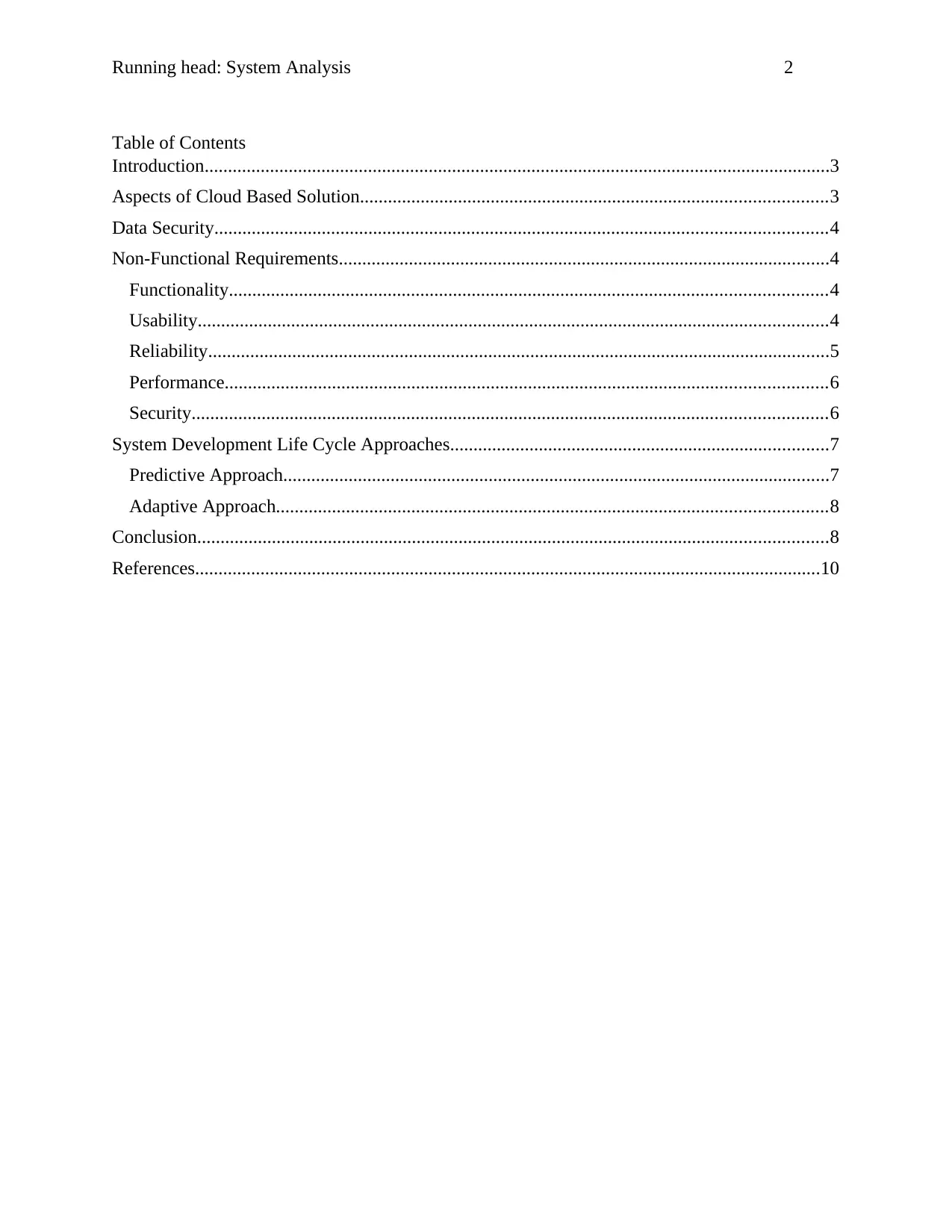
Running head: System Analysis 2
Table of Contents
Introduction......................................................................................................................................3
Aspects of Cloud Based Solution....................................................................................................3
Data Security...................................................................................................................................4
Non-Functional Requirements.........................................................................................................4
Functionality................................................................................................................................4
Usability.......................................................................................................................................4
Reliability.....................................................................................................................................5
Performance.................................................................................................................................6
Security........................................................................................................................................6
System Development Life Cycle Approaches.................................................................................7
Predictive Approach.....................................................................................................................7
Adaptive Approach......................................................................................................................8
Conclusion.......................................................................................................................................8
References......................................................................................................................................10
Table of Contents
Introduction......................................................................................................................................3
Aspects of Cloud Based Solution....................................................................................................3
Data Security...................................................................................................................................4
Non-Functional Requirements.........................................................................................................4
Functionality................................................................................................................................4
Usability.......................................................................................................................................4
Reliability.....................................................................................................................................5
Performance.................................................................................................................................6
Security........................................................................................................................................6
System Development Life Cycle Approaches.................................................................................7
Predictive Approach.....................................................................................................................7
Adaptive Approach......................................................................................................................8
Conclusion.......................................................................................................................................8
References......................................................................................................................................10
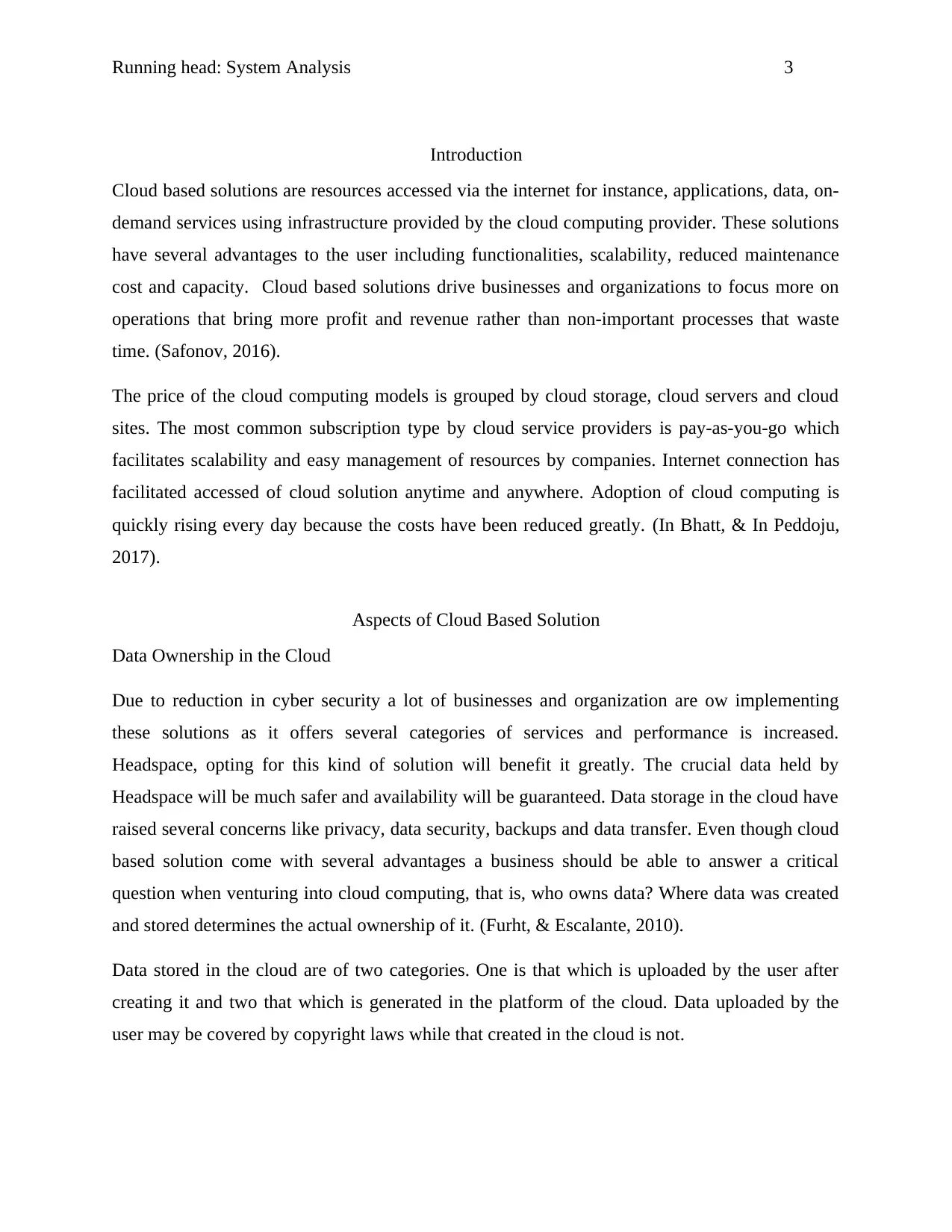
Running head: System Analysis 3
Introduction
Cloud based solutions are resources accessed via the internet for instance, applications, data, on-
demand services using infrastructure provided by the cloud computing provider. These solutions
have several advantages to the user including functionalities, scalability, reduced maintenance
cost and capacity. Cloud based solutions drive businesses and organizations to focus more on
operations that bring more profit and revenue rather than non-important processes that waste
time. (Safonov, 2016).
The price of the cloud computing models is grouped by cloud storage, cloud servers and cloud
sites. The most common subscription type by cloud service providers is pay-as-you-go which
facilitates scalability and easy management of resources by companies. Internet connection has
facilitated accessed of cloud solution anytime and anywhere. Adoption of cloud computing is
quickly rising every day because the costs have been reduced greatly. (In Bhatt, & In Peddoju,
2017).
Aspects of Cloud Based Solution
Data Ownership in the Cloud
Due to reduction in cyber security a lot of businesses and organization are ow implementing
these solutions as it offers several categories of services and performance is increased.
Headspace, opting for this kind of solution will benefit it greatly. The crucial data held by
Headspace will be much safer and availability will be guaranteed. Data storage in the cloud have
raised several concerns like privacy, data security, backups and data transfer. Even though cloud
based solution come with several advantages a business should be able to answer a critical
question when venturing into cloud computing, that is, who owns data? Where data was created
and stored determines the actual ownership of it. (Furht, & Escalante, 2010).
Data stored in the cloud are of two categories. One is that which is uploaded by the user after
creating it and two that which is generated in the platform of the cloud. Data uploaded by the
user may be covered by copyright laws while that created in the cloud is not.
Introduction
Cloud based solutions are resources accessed via the internet for instance, applications, data, on-
demand services using infrastructure provided by the cloud computing provider. These solutions
have several advantages to the user including functionalities, scalability, reduced maintenance
cost and capacity. Cloud based solutions drive businesses and organizations to focus more on
operations that bring more profit and revenue rather than non-important processes that waste
time. (Safonov, 2016).
The price of the cloud computing models is grouped by cloud storage, cloud servers and cloud
sites. The most common subscription type by cloud service providers is pay-as-you-go which
facilitates scalability and easy management of resources by companies. Internet connection has
facilitated accessed of cloud solution anytime and anywhere. Adoption of cloud computing is
quickly rising every day because the costs have been reduced greatly. (In Bhatt, & In Peddoju,
2017).
Aspects of Cloud Based Solution
Data Ownership in the Cloud
Due to reduction in cyber security a lot of businesses and organization are ow implementing
these solutions as it offers several categories of services and performance is increased.
Headspace, opting for this kind of solution will benefit it greatly. The crucial data held by
Headspace will be much safer and availability will be guaranteed. Data storage in the cloud have
raised several concerns like privacy, data security, backups and data transfer. Even though cloud
based solution come with several advantages a business should be able to answer a critical
question when venturing into cloud computing, that is, who owns data? Where data was created
and stored determines the actual ownership of it. (Furht, & Escalante, 2010).
Data stored in the cloud are of two categories. One is that which is uploaded by the user after
creating it and two that which is generated in the platform of the cloud. Data uploaded by the
user may be covered by copyright laws while that created in the cloud is not.
⊘ This is a preview!⊘
Do you want full access?
Subscribe today to unlock all pages.

Trusted by 1+ million students worldwide
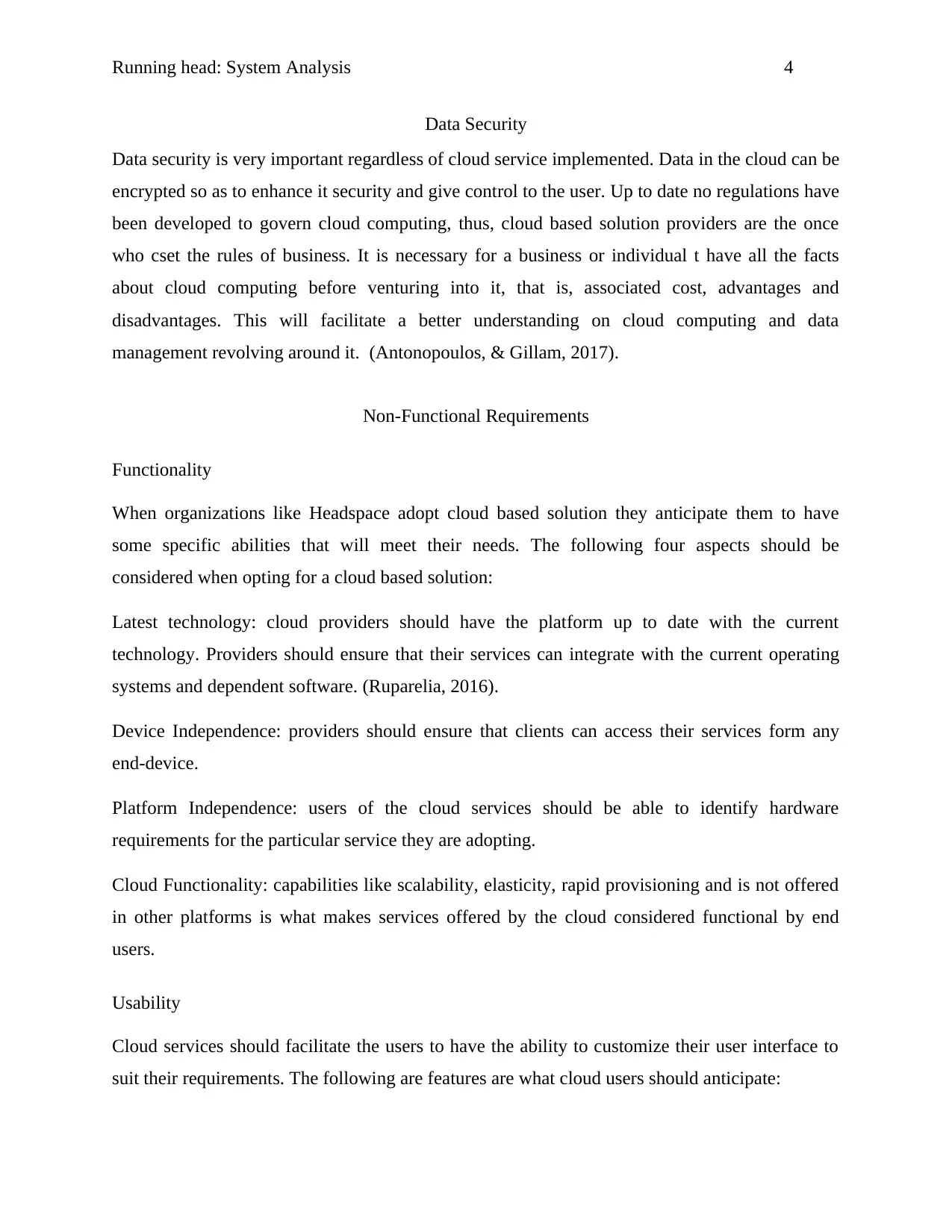
Running head: System Analysis 4
Data Security
Data security is very important regardless of cloud service implemented. Data in the cloud can be
encrypted so as to enhance it security and give control to the user. Up to date no regulations have
been developed to govern cloud computing, thus, cloud based solution providers are the once
who cset the rules of business. It is necessary for a business or individual t have all the facts
about cloud computing before venturing into it, that is, associated cost, advantages and
disadvantages. This will facilitate a better understanding on cloud computing and data
management revolving around it. (Antonopoulos, & Gillam, 2017).
Non-Functional Requirements
Functionality
When organizations like Headspace adopt cloud based solution they anticipate them to have
some specific abilities that will meet their needs. The following four aspects should be
considered when opting for a cloud based solution:
Latest technology: cloud providers should have the platform up to date with the current
technology. Providers should ensure that their services can integrate with the current operating
systems and dependent software. (Ruparelia, 2016).
Device Independence: providers should ensure that clients can access their services form any
end-device.
Platform Independence: users of the cloud services should be able to identify hardware
requirements for the particular service they are adopting.
Cloud Functionality: capabilities like scalability, elasticity, rapid provisioning and is not offered
in other platforms is what makes services offered by the cloud considered functional by end
users.
Usability
Cloud services should facilitate the users to have the ability to customize their user interface to
suit their requirements. The following are features are what cloud users should anticipate:
Data Security
Data security is very important regardless of cloud service implemented. Data in the cloud can be
encrypted so as to enhance it security and give control to the user. Up to date no regulations have
been developed to govern cloud computing, thus, cloud based solution providers are the once
who cset the rules of business. It is necessary for a business or individual t have all the facts
about cloud computing before venturing into it, that is, associated cost, advantages and
disadvantages. This will facilitate a better understanding on cloud computing and data
management revolving around it. (Antonopoulos, & Gillam, 2017).
Non-Functional Requirements
Functionality
When organizations like Headspace adopt cloud based solution they anticipate them to have
some specific abilities that will meet their needs. The following four aspects should be
considered when opting for a cloud based solution:
Latest technology: cloud providers should have the platform up to date with the current
technology. Providers should ensure that their services can integrate with the current operating
systems and dependent software. (Ruparelia, 2016).
Device Independence: providers should ensure that clients can access their services form any
end-device.
Platform Independence: users of the cloud services should be able to identify hardware
requirements for the particular service they are adopting.
Cloud Functionality: capabilities like scalability, elasticity, rapid provisioning and is not offered
in other platforms is what makes services offered by the cloud considered functional by end
users.
Usability
Cloud services should facilitate the users to have the ability to customize their user interface to
suit their requirements. The following are features are what cloud users should anticipate:
Paraphrase This Document
Need a fresh take? Get an instant paraphrase of this document with our AI Paraphraser
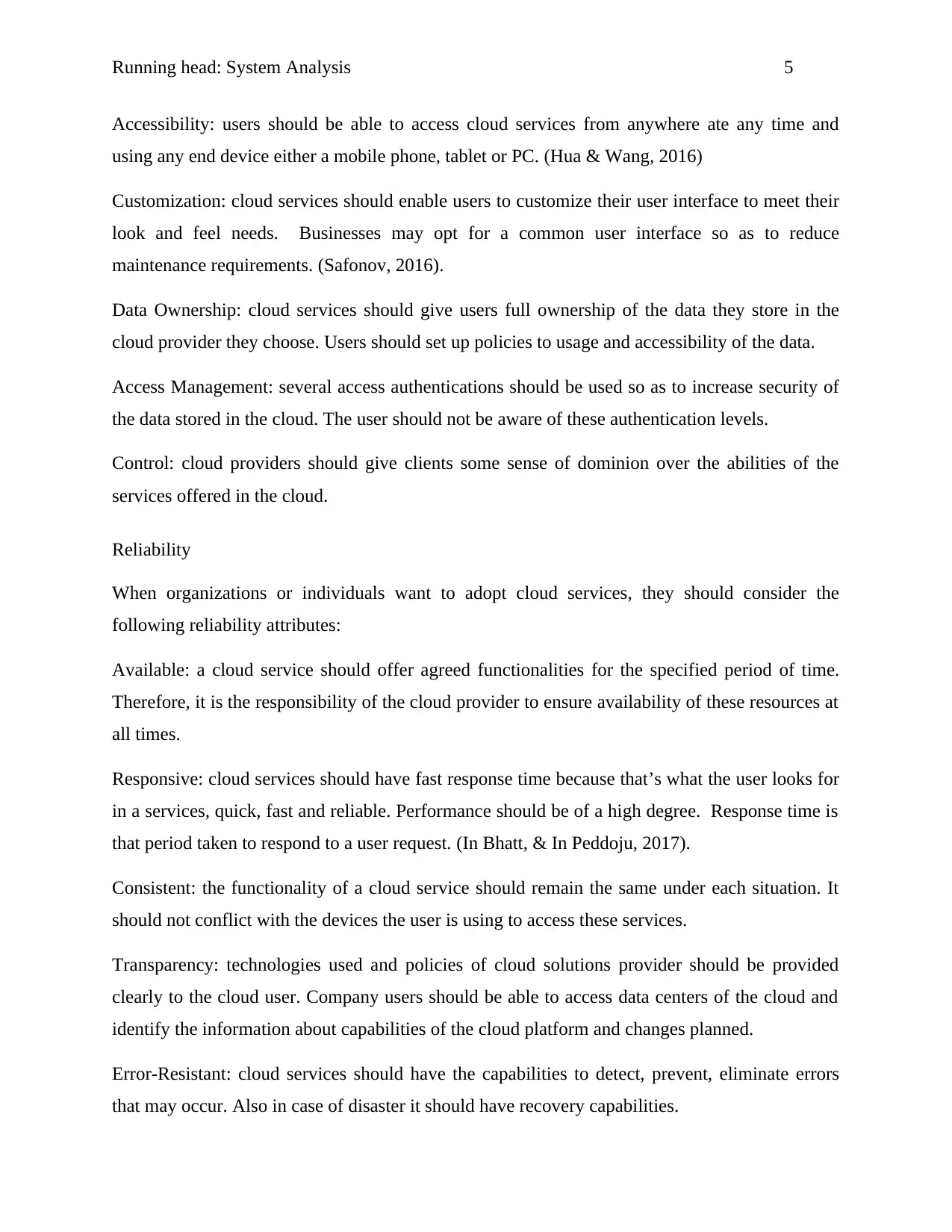
Running head: System Analysis 5
Accessibility: users should be able to access cloud services from anywhere ate any time and
using any end device either a mobile phone, tablet or PC. (Hua & Wang, 2016)
Customization: cloud services should enable users to customize their user interface to meet their
look and feel needs. Businesses may opt for a common user interface so as to reduce
maintenance requirements. (Safonov, 2016).
Data Ownership: cloud services should give users full ownership of the data they store in the
cloud provider they choose. Users should set up policies to usage and accessibility of the data.
Access Management: several access authentications should be used so as to increase security of
the data stored in the cloud. The user should not be aware of these authentication levels.
Control: cloud providers should give clients some sense of dominion over the abilities of the
services offered in the cloud.
Reliability
When organizations or individuals want to adopt cloud services, they should consider the
following reliability attributes:
Available: a cloud service should offer agreed functionalities for the specified period of time.
Therefore, it is the responsibility of the cloud provider to ensure availability of these resources at
all times.
Responsive: cloud services should have fast response time because that’s what the user looks for
in a services, quick, fast and reliable. Performance should be of a high degree. Response time is
that period taken to respond to a user request. (In Bhatt, & In Peddoju, 2017).
Consistent: the functionality of a cloud service should remain the same under each situation. It
should not conflict with the devices the user is using to access these services.
Transparency: technologies used and policies of cloud solutions provider should be provided
clearly to the cloud user. Company users should be able to access data centers of the cloud and
identify the information about capabilities of the cloud platform and changes planned.
Error-Resistant: cloud services should have the capabilities to detect, prevent, eliminate errors
that may occur. Also in case of disaster it should have recovery capabilities.
Accessibility: users should be able to access cloud services from anywhere ate any time and
using any end device either a mobile phone, tablet or PC. (Hua & Wang, 2016)
Customization: cloud services should enable users to customize their user interface to meet their
look and feel needs. Businesses may opt for a common user interface so as to reduce
maintenance requirements. (Safonov, 2016).
Data Ownership: cloud services should give users full ownership of the data they store in the
cloud provider they choose. Users should set up policies to usage and accessibility of the data.
Access Management: several access authentications should be used so as to increase security of
the data stored in the cloud. The user should not be aware of these authentication levels.
Control: cloud providers should give clients some sense of dominion over the abilities of the
services offered in the cloud.
Reliability
When organizations or individuals want to adopt cloud services, they should consider the
following reliability attributes:
Available: a cloud service should offer agreed functionalities for the specified period of time.
Therefore, it is the responsibility of the cloud provider to ensure availability of these resources at
all times.
Responsive: cloud services should have fast response time because that’s what the user looks for
in a services, quick, fast and reliable. Performance should be of a high degree. Response time is
that period taken to respond to a user request. (In Bhatt, & In Peddoju, 2017).
Consistent: the functionality of a cloud service should remain the same under each situation. It
should not conflict with the devices the user is using to access these services.
Transparency: technologies used and policies of cloud solutions provider should be provided
clearly to the cloud user. Company users should be able to access data centers of the cloud and
identify the information about capabilities of the cloud platform and changes planned.
Error-Resistant: cloud services should have the capabilities to detect, prevent, eliminate errors
that may occur. Also in case of disaster it should have recovery capabilities.
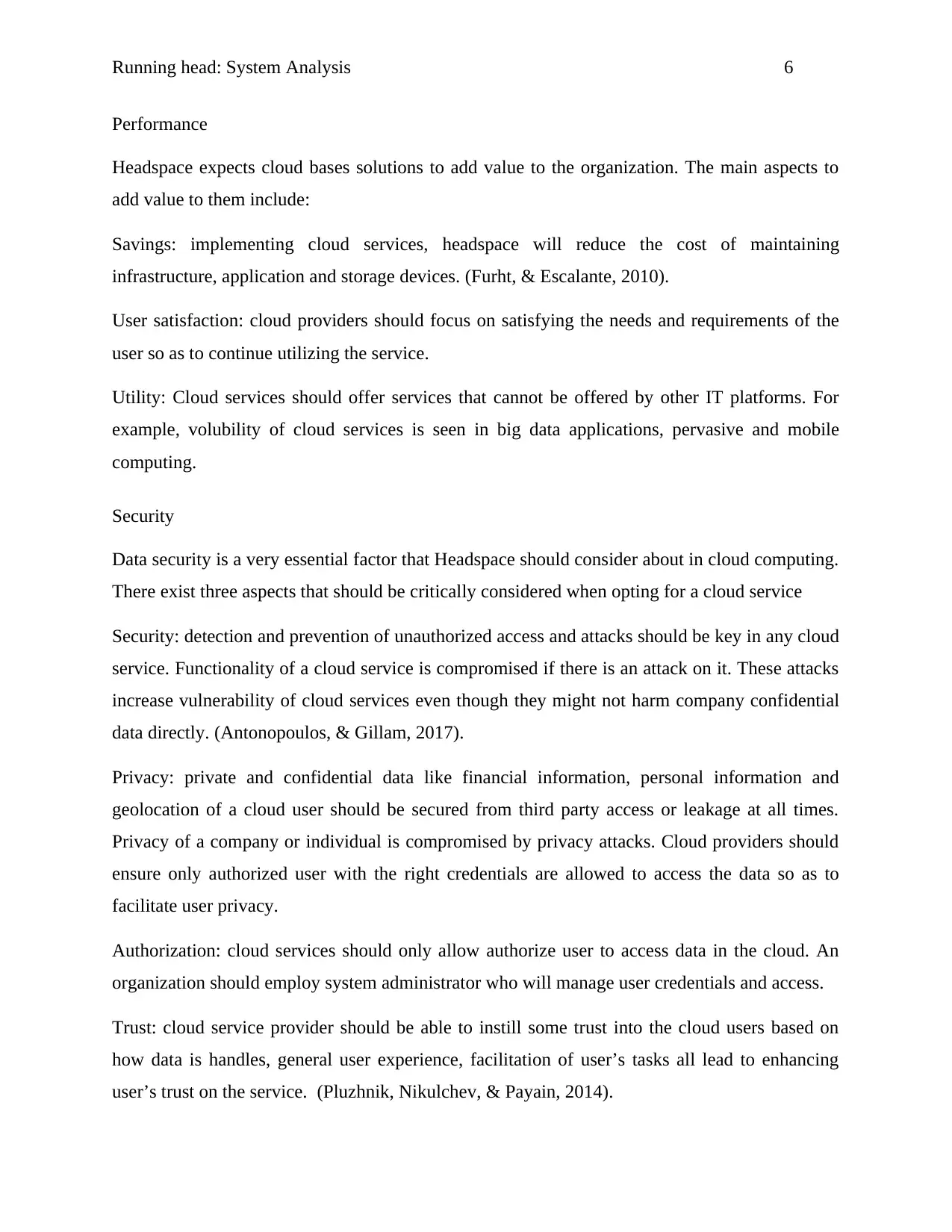
Running head: System Analysis 6
Performance
Headspace expects cloud bases solutions to add value to the organization. The main aspects to
add value to them include:
Savings: implementing cloud services, headspace will reduce the cost of maintaining
infrastructure, application and storage devices. (Furht, & Escalante, 2010).
User satisfaction: cloud providers should focus on satisfying the needs and requirements of the
user so as to continue utilizing the service.
Utility: Cloud services should offer services that cannot be offered by other IT platforms. For
example, volubility of cloud services is seen in big data applications, pervasive and mobile
computing.
Security
Data security is a very essential factor that Headspace should consider about in cloud computing.
There exist three aspects that should be critically considered when opting for a cloud service
Security: detection and prevention of unauthorized access and attacks should be key in any cloud
service. Functionality of a cloud service is compromised if there is an attack on it. These attacks
increase vulnerability of cloud services even though they might not harm company confidential
data directly. (Antonopoulos, & Gillam, 2017).
Privacy: private and confidential data like financial information, personal information and
geolocation of a cloud user should be secured from third party access or leakage at all times.
Privacy of a company or individual is compromised by privacy attacks. Cloud providers should
ensure only authorized user with the right credentials are allowed to access the data so as to
facilitate user privacy.
Authorization: cloud services should only allow authorize user to access data in the cloud. An
organization should employ system administrator who will manage user credentials and access.
Trust: cloud service provider should be able to instill some trust into the cloud users based on
how data is handles, general user experience, facilitation of user’s tasks all lead to enhancing
user’s trust on the service. (Pluzhnik, Nikulchev, & Payain, 2014).
Performance
Headspace expects cloud bases solutions to add value to the organization. The main aspects to
add value to them include:
Savings: implementing cloud services, headspace will reduce the cost of maintaining
infrastructure, application and storage devices. (Furht, & Escalante, 2010).
User satisfaction: cloud providers should focus on satisfying the needs and requirements of the
user so as to continue utilizing the service.
Utility: Cloud services should offer services that cannot be offered by other IT platforms. For
example, volubility of cloud services is seen in big data applications, pervasive and mobile
computing.
Security
Data security is a very essential factor that Headspace should consider about in cloud computing.
There exist three aspects that should be critically considered when opting for a cloud service
Security: detection and prevention of unauthorized access and attacks should be key in any cloud
service. Functionality of a cloud service is compromised if there is an attack on it. These attacks
increase vulnerability of cloud services even though they might not harm company confidential
data directly. (Antonopoulos, & Gillam, 2017).
Privacy: private and confidential data like financial information, personal information and
geolocation of a cloud user should be secured from third party access or leakage at all times.
Privacy of a company or individual is compromised by privacy attacks. Cloud providers should
ensure only authorized user with the right credentials are allowed to access the data so as to
facilitate user privacy.
Authorization: cloud services should only allow authorize user to access data in the cloud. An
organization should employ system administrator who will manage user credentials and access.
Trust: cloud service provider should be able to instill some trust into the cloud users based on
how data is handles, general user experience, facilitation of user’s tasks all lead to enhancing
user’s trust on the service. (Pluzhnik, Nikulchev, & Payain, 2014).
⊘ This is a preview!⊘
Do you want full access?
Subscribe today to unlock all pages.

Trusted by 1+ million students worldwide
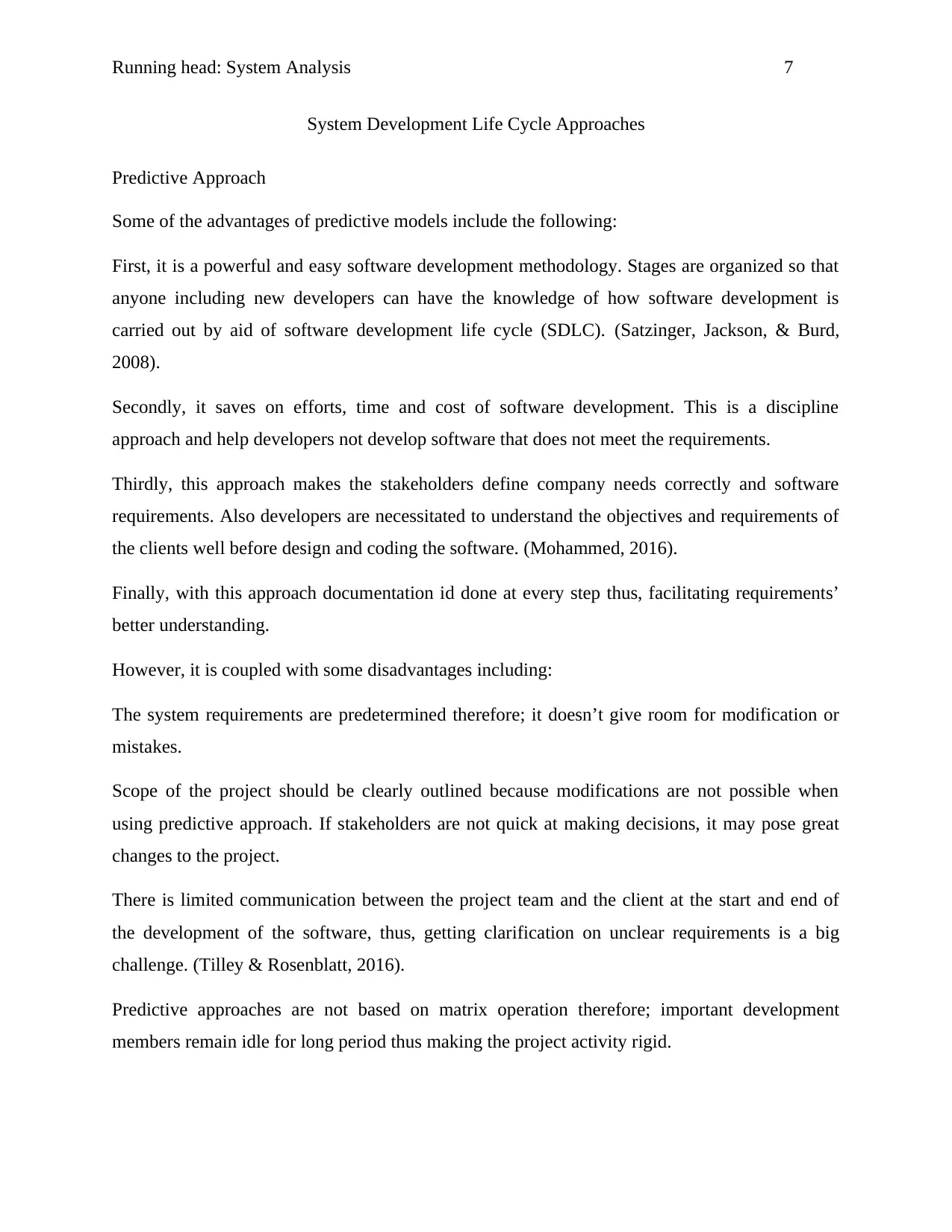
Running head: System Analysis 7
System Development Life Cycle Approaches
Predictive Approach
Some of the advantages of predictive models include the following:
First, it is a powerful and easy software development methodology. Stages are organized so that
anyone including new developers can have the knowledge of how software development is
carried out by aid of software development life cycle (SDLC). (Satzinger, Jackson, & Burd,
2008).
Secondly, it saves on efforts, time and cost of software development. This is a discipline
approach and help developers not develop software that does not meet the requirements.
Thirdly, this approach makes the stakeholders define company needs correctly and software
requirements. Also developers are necessitated to understand the objectives and requirements of
the clients well before design and coding the software. (Mohammed, 2016).
Finally, with this approach documentation id done at every step thus, facilitating requirements’
better understanding.
However, it is coupled with some disadvantages including:
The system requirements are predetermined therefore; it doesn’t give room for modification or
mistakes.
Scope of the project should be clearly outlined because modifications are not possible when
using predictive approach. If stakeholders are not quick at making decisions, it may pose great
changes to the project.
There is limited communication between the project team and the client at the start and end of
the development of the software, thus, getting clarification on unclear requirements is a big
challenge. (Tilley & Rosenblatt, 2016).
Predictive approaches are not based on matrix operation therefore; important development
members remain idle for long period thus making the project activity rigid.
System Development Life Cycle Approaches
Predictive Approach
Some of the advantages of predictive models include the following:
First, it is a powerful and easy software development methodology. Stages are organized so that
anyone including new developers can have the knowledge of how software development is
carried out by aid of software development life cycle (SDLC). (Satzinger, Jackson, & Burd,
2008).
Secondly, it saves on efforts, time and cost of software development. This is a discipline
approach and help developers not develop software that does not meet the requirements.
Thirdly, this approach makes the stakeholders define company needs correctly and software
requirements. Also developers are necessitated to understand the objectives and requirements of
the clients well before design and coding the software. (Mohammed, 2016).
Finally, with this approach documentation id done at every step thus, facilitating requirements’
better understanding.
However, it is coupled with some disadvantages including:
The system requirements are predetermined therefore; it doesn’t give room for modification or
mistakes.
Scope of the project should be clearly outlined because modifications are not possible when
using predictive approach. If stakeholders are not quick at making decisions, it may pose great
changes to the project.
There is limited communication between the project team and the client at the start and end of
the development of the software, thus, getting clarification on unclear requirements is a big
challenge. (Tilley & Rosenblatt, 2016).
Predictive approaches are not based on matrix operation therefore; important development
members remain idle for long period thus making the project activity rigid.
Paraphrase This Document
Need a fresh take? Get an instant paraphrase of this document with our AI Paraphraser
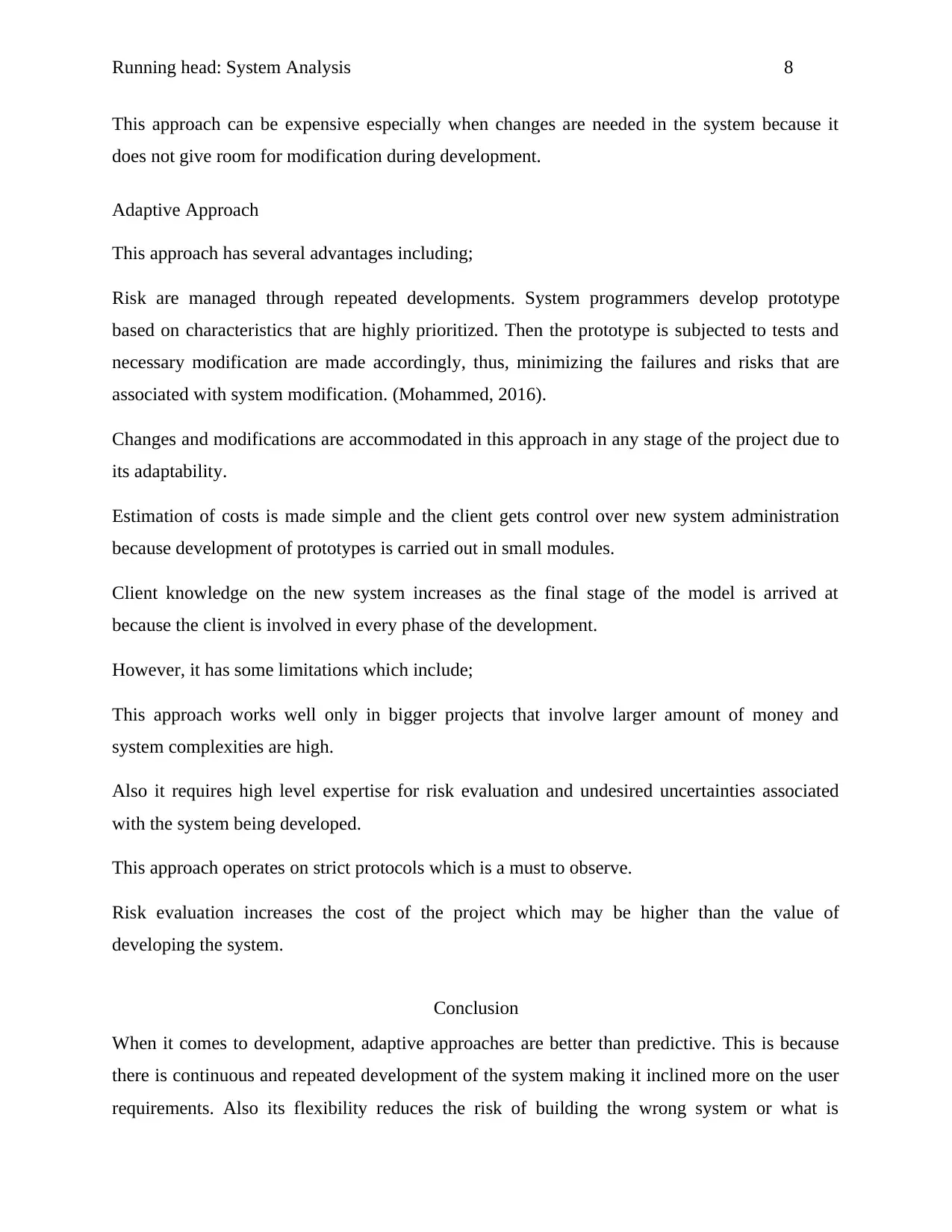
Running head: System Analysis 8
This approach can be expensive especially when changes are needed in the system because it
does not give room for modification during development.
Adaptive Approach
This approach has several advantages including;
Risk are managed through repeated developments. System programmers develop prototype
based on characteristics that are highly prioritized. Then the prototype is subjected to tests and
necessary modification are made accordingly, thus, minimizing the failures and risks that are
associated with system modification. (Mohammed, 2016).
Changes and modifications are accommodated in this approach in any stage of the project due to
its adaptability.
Estimation of costs is made simple and the client gets control over new system administration
because development of prototypes is carried out in small modules.
Client knowledge on the new system increases as the final stage of the model is arrived at
because the client is involved in every phase of the development.
However, it has some limitations which include;
This approach works well only in bigger projects that involve larger amount of money and
system complexities are high.
Also it requires high level expertise for risk evaluation and undesired uncertainties associated
with the system being developed.
This approach operates on strict protocols which is a must to observe.
Risk evaluation increases the cost of the project which may be higher than the value of
developing the system.
Conclusion
When it comes to development, adaptive approaches are better than predictive. This is because
there is continuous and repeated development of the system making it inclined more on the user
requirements. Also its flexibility reduces the risk of building the wrong system or what is
This approach can be expensive especially when changes are needed in the system because it
does not give room for modification during development.
Adaptive Approach
This approach has several advantages including;
Risk are managed through repeated developments. System programmers develop prototype
based on characteristics that are highly prioritized. Then the prototype is subjected to tests and
necessary modification are made accordingly, thus, minimizing the failures and risks that are
associated with system modification. (Mohammed, 2016).
Changes and modifications are accommodated in this approach in any stage of the project due to
its adaptability.
Estimation of costs is made simple and the client gets control over new system administration
because development of prototypes is carried out in small modules.
Client knowledge on the new system increases as the final stage of the model is arrived at
because the client is involved in every phase of the development.
However, it has some limitations which include;
This approach works well only in bigger projects that involve larger amount of money and
system complexities are high.
Also it requires high level expertise for risk evaluation and undesired uncertainties associated
with the system being developed.
This approach operates on strict protocols which is a must to observe.
Risk evaluation increases the cost of the project which may be higher than the value of
developing the system.
Conclusion
When it comes to development, adaptive approaches are better than predictive. This is because
there is continuous and repeated development of the system making it inclined more on the user
requirements. Also its flexibility reduces the risk of building the wrong system or what is
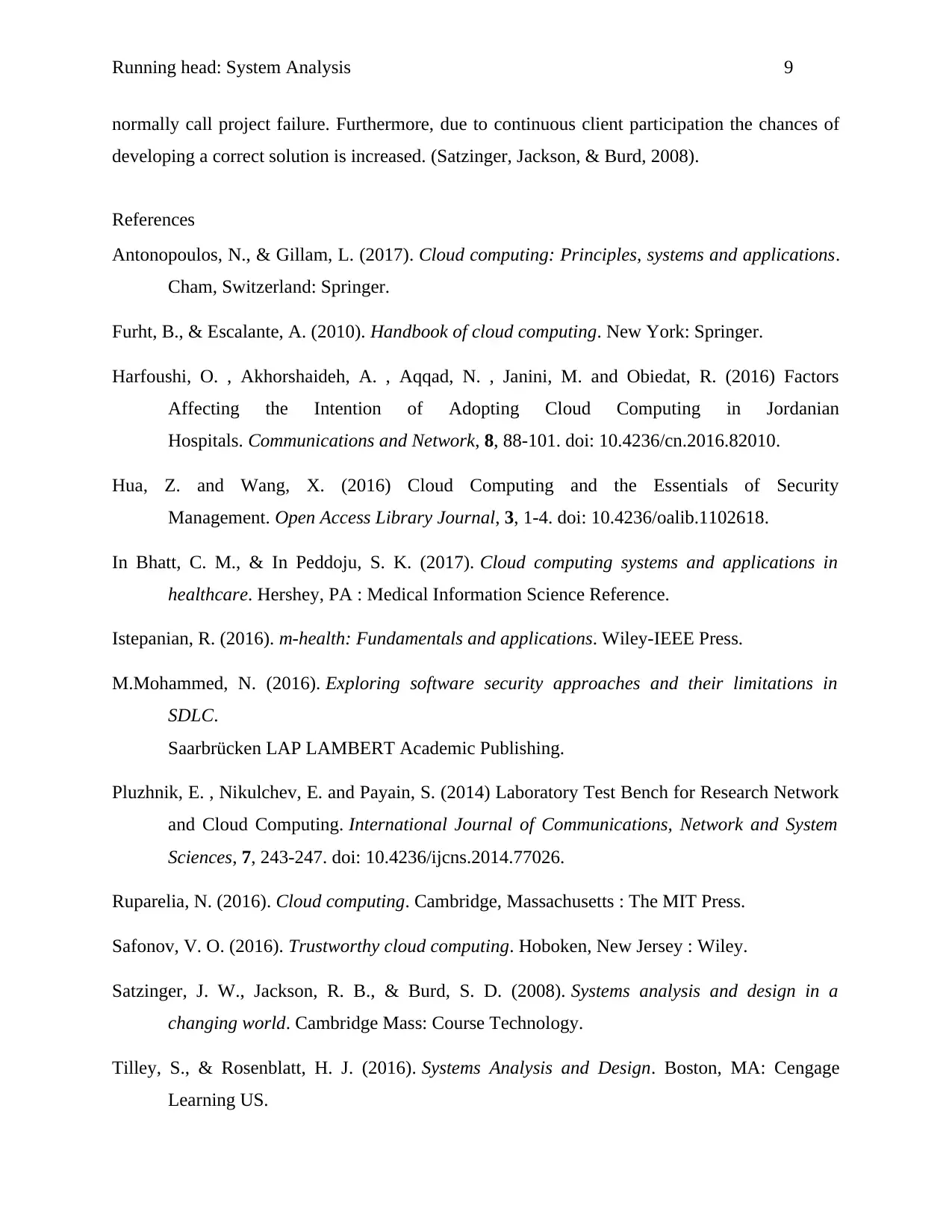
Running head: System Analysis 9
normally call project failure. Furthermore, due to continuous client participation the chances of
developing a correct solution is increased. (Satzinger, Jackson, & Burd, 2008).
References
Antonopoulos, N., & Gillam, L. (2017). Cloud computing: Principles, systems and applications.
Cham, Switzerland: Springer.
Furht, B., & Escalante, A. (2010). Handbook of cloud computing. New York: Springer.
Harfoushi, O. , Akhorshaideh, A. , Aqqad, N. , Janini, M. and Obiedat, R. (2016) Factors
Affecting the Intention of Adopting Cloud Computing in Jordanian
Hospitals. Communications and Network, 8, 88-101. doi: 10.4236/cn.2016.82010.
Hua, Z. and Wang, X. (2016) Cloud Computing and the Essentials of Security
Management. Open Access Library Journal, 3, 1-4. doi: 10.4236/oalib.1102618.
In Bhatt, C. M., & In Peddoju, S. K. (2017). Cloud computing systems and applications in
healthcare. Hershey, PA : Medical Information Science Reference.
Istepanian, R. (2016). m-health: Fundamentals and applications. Wiley-IEEE Press.
M.Mohammed, N. (2016). Exploring software security approaches and their limitations in
SDLC.
Saarbrücken LAP LAMBERT Academic Publishing.
Pluzhnik, E. , Nikulchev, E. and Payain, S. (2014) Laboratory Test Bench for Research Network
and Cloud Computing. International Journal of Communications, Network and System
Sciences, 7, 243-247. doi: 10.4236/ijcns.2014.77026.
Ruparelia, N. (2016). Cloud computing. Cambridge, Massachusetts : The MIT Press.
Safonov, V. O. (2016). Trustworthy cloud computing. Hoboken, New Jersey : Wiley.
Satzinger, J. W., Jackson, R. B., & Burd, S. D. (2008). Systems analysis and design in a
changing world. Cambridge Mass: Course Technology.
Tilley, S., & Rosenblatt, H. J. (2016). Systems Analysis and Design. Boston, MA: Cengage
Learning US.
normally call project failure. Furthermore, due to continuous client participation the chances of
developing a correct solution is increased. (Satzinger, Jackson, & Burd, 2008).
References
Antonopoulos, N., & Gillam, L. (2017). Cloud computing: Principles, systems and applications.
Cham, Switzerland: Springer.
Furht, B., & Escalante, A. (2010). Handbook of cloud computing. New York: Springer.
Harfoushi, O. , Akhorshaideh, A. , Aqqad, N. , Janini, M. and Obiedat, R. (2016) Factors
Affecting the Intention of Adopting Cloud Computing in Jordanian
Hospitals. Communications and Network, 8, 88-101. doi: 10.4236/cn.2016.82010.
Hua, Z. and Wang, X. (2016) Cloud Computing and the Essentials of Security
Management. Open Access Library Journal, 3, 1-4. doi: 10.4236/oalib.1102618.
In Bhatt, C. M., & In Peddoju, S. K. (2017). Cloud computing systems and applications in
healthcare. Hershey, PA : Medical Information Science Reference.
Istepanian, R. (2016). m-health: Fundamentals and applications. Wiley-IEEE Press.
M.Mohammed, N. (2016). Exploring software security approaches and their limitations in
SDLC.
Saarbrücken LAP LAMBERT Academic Publishing.
Pluzhnik, E. , Nikulchev, E. and Payain, S. (2014) Laboratory Test Bench for Research Network
and Cloud Computing. International Journal of Communications, Network and System
Sciences, 7, 243-247. doi: 10.4236/ijcns.2014.77026.
Ruparelia, N. (2016). Cloud computing. Cambridge, Massachusetts : The MIT Press.
Safonov, V. O. (2016). Trustworthy cloud computing. Hoboken, New Jersey : Wiley.
Satzinger, J. W., Jackson, R. B., & Burd, S. D. (2008). Systems analysis and design in a
changing world. Cambridge Mass: Course Technology.
Tilley, S., & Rosenblatt, H. J. (2016). Systems Analysis and Design. Boston, MA: Cengage
Learning US.
⊘ This is a preview!⊘
Do you want full access?
Subscribe today to unlock all pages.

Trusted by 1+ million students worldwide

Running head: System Analysis 10
1 out of 10
Related Documents
Your All-in-One AI-Powered Toolkit for Academic Success.
+13062052269
info@desklib.com
Available 24*7 on WhatsApp / Email
![[object Object]](/_next/static/media/star-bottom.7253800d.svg)
Unlock your academic potential
Copyright © 2020–2025 A2Z Services. All Rights Reserved. Developed and managed by ZUCOL.





